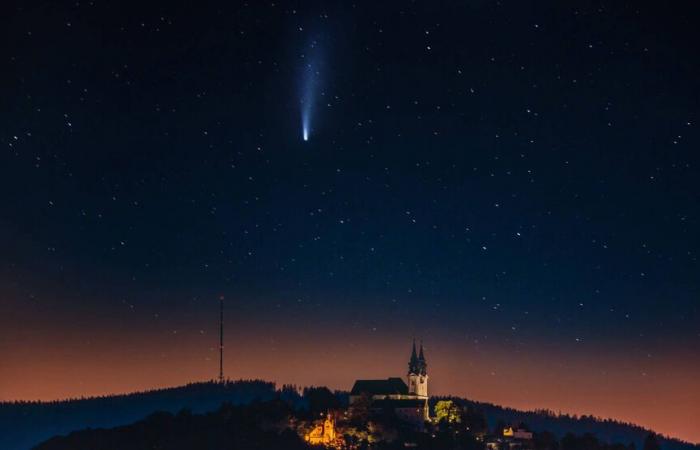Comet C/2022 E3 (ZTF) – what sounds so unspectacular could shine in the night sky in January. The next comet in 2023 may be visible to the naked eye.
Comets are several billion years old and date from the early days of our solar system. At the end of January one may be visible again in the sky with the naked eye: Comet C/2022 E3 (ZTF) is approaching Earth and the Sun at breakneck speed – and is getting a little brighter by the day.
- When can the comet be seen in January 2023?
- How to find Comet C/2022 E3 (ZTF) in the sky?
- How bright will the next comet be in 2023?
Here is all the information about Comet C/2022 E3 (ZTF) in January and February 2023.
What is Comet C/2022 E3 (ZTF)?
Comet C/2022 E3 (ZTF) is a so-called long-period comet, i.e. a clump of ice, dust and rock that moves in a stable orbit around the sun. The comet probably needs more than 200 years for such an orbit. Like all comets, this one is probably several billion years old and dates from the early days of our solar system.
When was Comet C/2022 E3 (ZTF) discovered?
The dirty snowball, as comets are also known, was discovered in early March 2022 by astronomers Bryce Bolin and Frank Masci.
How did the comet get its name?
Comets get their names according to a uniform scheme that is made up of the time of discovery and its orbital period. In this case the name C/2022 E3 (ZTF) means:
- C = the comet has an orbital period of more than 200 years
- 2022 = the year of discovery
- E = the exact time of discovery. The count begins with A on January 1st, followed by B on January 16th and so it continues in a two-week rhythm. E stands for early March.
- 3 = the third comet discovered in the first half of March.
What does ZTF mean?
ZTF stands for the Zwicky Transient Facility project, as part of which the night sky is being searched in a structured way with a special wide-angle camera, and the comet was discovered in 2022.
What is the path of the next comet in 2023?
Comet C/2022 E3 (ZTF) now approaching the Sun will be closest to the Sun on January 12 at a distance of 166 million km. It will then be closest to the Earth on February 1, 2023 at around 42 million kilometers.
When can I see Comet C/2022 E3 (ZTF) in the sky?
If the (weather) conditions are good, the comet can already be seen in the dark night sky with a telescope. How things will continue in the coming weeks is not yet entirely clear. “Comets are notoriously unpredictable, but if this comet continues its current trend in brightness, it will be easy to see with binoculars, and there is a good chance it will become visible to the unaided eye in dark skies,” NASA said.
Experts believe that the comet may in the last week of January – i.e. around January 24th – could be seen in the sky with the naked eye.
How bright will comet C/2022 E3 (ZTF) be?
That too is not entirely clear. C/2022 E3 (ZTF) will probably not compare with the spectacular comet Neowise in 2020. Rather, the comet should look more like a washed-out spot in the sky. After all: Because it is very high in the sky, the January comet will probably be visible throughout the night at the end of January/beginning of February.
Where can I see the comet in the sky in January?
Observers in the northern hemisphere will find the comet in the morning sky as it moves rapidly northwest in January, Nasa says.


